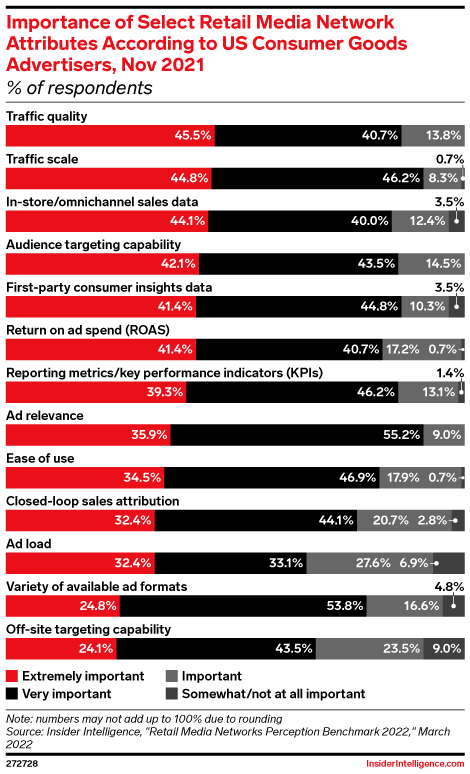Why should advertisers choose your ecommerce media?

Retail media is becoming the fastest growing advertising channel and is now offered by more and more online retailers and marketplaces.
Why is it so appealing to advertisers and sellers and what are the important attributes that make some websites more popular than others?
The answers to these questions are super important to online retailers that are building their way in the retail media space because it can help them fine tune their media offerings and drive more ad budget to their websites.
Before we answer these questions, we need to clearly distinguish between the 2 types of advertisers – The brand advertisers and the marketplace sellers.
Retail media can help both types achieve several goals – Increase sales, raise awareness, protect market share, introduce new products etc. – but while marketplace sellers do it mainly for performance and sales, brand advertisers see it as part of their advertising mix and seek up the funnel marketing goals as well.
In this post we will focus on brand advertisers.
Last month Insider Intelligence and eMarketer released the first ever US retail media networks benchmark report that evaluated digital ad buyers’ perceptions of leading US retail media networks – Amazon Ads, Best Buy Ads, Costco Wholesale, eBay Ads, The Home Depot Retail Media+, Instacart Ads, Kroger Precision Marketing, Macy’s Media Network, Roundel (Target), Walmart Connect, and Wayfair Media Solutions.
They surveyed 145 US advertising agencies and consumer goods advertisers and they all gave all the retail media networks relatively high marks with 10 of 11 recording a score of 4.0 or higher on a 5-point scale.
The attributes that were examined rolled up into four pillars: traffic, first-party data, targeting and measurement, and platform experience.

Eyeballs are still king
Traffic was ranked the most important attribute, with traffic scale scoring 4.35 and traffic quality scoring 4.32 on a five-point-scale.
It’s not only the ability to reach a large enough audience of shoppers but also reaching the right customers with a high likelihood to convert.
ROAS, return on ad spend, was only 6th on the list. In-store/omnichannel sales data, Audience targeting capability, First-party consumer insights data and the traffic attributes were more important to the advertisers than the ROAS (or ACoS).
This makes perfect sense as the marketing goals are not all about performance. For more awareness and eyeballs – traffic and relevant traffic are the most important factors. Just like when an advertiser selects which TV show to be on, it is based on the rating (number of viewers) and what type of viewers are watching it.

What should the online stores take from this insight? Communicate and pitch your traffic advantages. If you are the leaders in your vertical or serve the hi-end shoppers or the top spenders in your space, then the advertisers should be aware of that as it will affect how much ad dollars they will spend. The advertisers need to understand the extra value of advertising on your website.
First party data – What is it good for?
The survey also found that in-store/omnichannel sales data ranked No. 3 on the “extremely important” scale. In general, the first party data pilar was the 2nd most important one, especially for CPG advertisers.
Advertisers see data as a key value driver.
The take of Insider Intelligence was that “First-party data is a big draw for brands that have traditionally lacked visibility into consumers’ product selection criteria, path to purchase, and decision-making at the store shelf. Provisioning of this data is a huge draw for brands, and there’s an opportunity for retail media networks to gain traction simply by making anonymized and aggregated consumer insights as accessible and user-friendly as possible. There is also considerable upside in integrating omnichannel/offline sales data to connect the dots between digital advertising and in-store purchase behavior, which accounts for more than 80% of US retail sales today.”
These findings are aligned with those that were published by eMarketer and Merkle 2 years ago.
In their RETAIL MEDIA NETWORKS 2019 report they claimed that companies best positioned to monetize their customer base through advertising will have both quantity and quality of first-party customer data, heavy online traffic volume, an advertising tech stack and an organizational commitment to the business.
What is this 1st party data that is so important to advertisers?
“They have purchase intent and actual purchase data. This is something both Google and Facebook are not the best at, but which is very useful for targeting and segmentation,” said Nate Shurilla, global director of commerce and voice at performance marketing agency iProspect.

What is the take for online stores? Make sure you share the relevant data with advertisers in a way they can easily use it. Even the seemingly basic data such as impressions, clicks, conversion, ROAS etc. is not so basic and obvious. This is not something they can easily find when they run campaigns on Google or Facebook. If you want to be more open with your advertisers you can share more in depth stats and data such as market share, benchmarks etc.
Platform is key
The retail media networks benchmark report also found that platform experience is one of the most important—and often underappreciated—aspects of retail media network adoption.
The take of Insider Intelligence was that “As the retail media market gets increasingly competitive, every retail media network should have a minimum bar of self-serve ad capabilities, a simple and streamlined user experience, and strong customer service support to gain adoption from brands. Retailers must also ensure that issues like ad load and irrelevant ads don’t detract from the customer’s experience. “

The take for retailers: Don’t try to re-invent the wheel. Offer an easy-to-use intuitive self service UI to your brand advertisers. Keep it simple so they keep using it and make the most out of it.
Although it is self served, there will still be some need for in-house support to advertisers that need it.
2 other important take aways from the recent report:
92.6% of respondents had used at least two retail media networks, 30.4% of respondents had used three!
This means that advertisers do not settle for just marking Amazon on their “retail media” check list. They understand the potential of retail media and are open to spend their retail media budget on relevant stores.
The ecommerce websites need to make sure these advertisers are aware of their media offerings.
While Amazon is generating more than $30B a year selling ads compared to eBay’s ~$1B, eBay Ads upset Amazon Ads to rank as the No. 1 overall retail media network.
This demonstrates that it’s not necessary to be the biggest to be the best. As said in the report: eBay Ads did a standout job of meeting their needs across attributes.
About Mabaya
Mabaya, a Criteo company, offers a white-label self-service retail media platform for online retailers and marketplaces that enables sellers and brands to bid in order to ensure their products are listed in premium locations in the online store.
The platform is integrated in more than 50 ecommerce sites around the globe (such as Bol.com, Jumia, Manomano, Kaufland, Hepsiburada, Falabella etc.), serving more than 70,000 advertisers and sellers.

